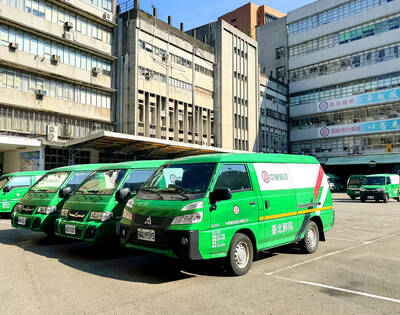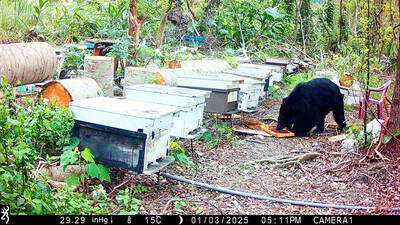The high cost of a submarine-rescue service agreement with the US has led some to wonder whether the navy is considering other options to secure the safety of the crews of the nation's four subs, but according to unnamed sources, there is no plan to do so, even though it could take more than a day for the Americans to come to the rescue.
The agreement was the work of ex-navy commander-in-chief retired Admiral Nelson Ku (顧崇廉), who is now a PFP lawmaker. Ku was the navy's chief from 1994 to 1997.
The agreement was one of Ku's greatest contributions to the navy, because a distressed submarine would have had to rely on its own devices before it was signed.
Submarine crews doubtless have peace of mind under the rescue agreement, but it has come to light that the navy is paying a large sum of money for a program which has never been used. No information is available about the cost of the program because those party to the agreement are sworn to secrecy.
The navy currently has four submarines, including two older vessels acquired from the US and two modern ones bought from the Netherlands.
Before the navy signed the submarine-rescue agreement with the US during Ku's term as the navy chief, the the crew of four submarines could only hope for a miracle if they had an accident that incapacitated the vessel.
An official with the navy, who spoke on condition of anonymity, said the navy's submarine rescue agreement with the US is confidential and that it is not proper for the navy to openly discuss it.
According to Chinese-language news reports on the subject, the navy's agreement with the US states that the US is required to send a deep submergence rescue vehicle (DSRV) to Taiwan in the shortest time possible if any of Taiwan's four submarines become disabled.
If needed, a DSRV would be delivered to Taiwan via a transport airplane and then shipped to the accident site via a ship.
Two years ago, one of the two Holland-made submarines struck an underwater object, sustaining considerable damage to its bow. It is probably the only occasion that the navy came close to having a need for the DSRV service.
Taiwan's military periodically comes under pressure from industries and legislators to help stimulate the local economy by refusing to buy from foreign sources and sign contracts with local companies, but in the case of submarine rescue, it appears as though there are few alternatives. Asked about whether it is necessary for Taiwan to develop its own submarine-rescue capabilities, the navy said it has no such plan at the moment because the cost would be too high.
In 10 years, the navy might buy another eight diesel-electric submarines from the US. After these eight submarines go into service, the navy would be faced with an increased possibility of experiencing a submarine disaster.
Even under this scenario, the navy responded by saying that the cost likely would be prohibitive.
A naval official said that although foreign aid might not be able to come on time, a disabled submarine has enough oxygen for its crew for two days.
"In two days, the DSRV could arrive here," a naval official said.

SHIPS, TRAINS AND AUTOMOBILES: The ministry has announced changes to varied transportation industries taking effect soon, with a number of effects for passengers Beginning next month, the post office is canceling signature upon delivery and written inquiry services for international registered small packets in accordance with the new policy of the Universal Postal Union, the Ministry of Transportation and Communications said yesterday. The new policy does not apply to packets that are to be delivered to China, the ministry said. Senders of international registered small packets would receive a NT$10 rebate on postage if the packets are sent from Jan. 1 to March 31, it added. The ministry said that three other policies are also scheduled to take effect next month. International cruise ship operators

HORROR STORIES: One victim recounted not realizing they had been stabbed and seeing people bleeding, while another recalled breaking down in tears after fleeing A man on Friday died after he tried to fight the knife-wielding suspect who went on a stabbing spree near two of Taipei’s busiest metro stations, Taipei Mayor Chiang Wan-an (蔣萬安) said. The 57-year-old man, identified by his family name, Yu (余), encountered the suspect at Exit M7 of Taipei Main Station and immediately tried to stop him, but was fatally wounded and later died, Chiang said, calling the incident “heartbreaking.” Yu’s family would receive at least NT$5 million (US$158,584) in compensation through the Taipei Rapid Transit Corp’s (TRTC) insurance coverage, he said after convening an emergency security response meeting yesterday morning. National

PLANNED: The suspect visited the crime scene before the killings, seeking information on how to access the roof, and had extensively researched a 2014 stabbing incident The suspect in a stabbing attack that killed three people and injured 11 in Taipei on Friday had planned the assault and set fires at other locations earlier in the day, law enforcement officials said yesterday. National Police Agency (NPA) Director-General Chang Jung-hsin (張榮興) said the suspect, a 27-year-old man named Chang Wen (張文), began the attacks at 3:40pm, first setting off smoke bombs on a road, damaging cars and motorbikes. Earlier, Chang Wen set fire to a rental room where he was staying on Gongyuan Road in Zhongzheng District (中正), Chang Jung-hsin said. The suspect later threw smoke grenades near two exits

The Forestry and Nature Conservation Agency yesterday launched a gift box to market honey “certified by a Formosan black bear” in appreciation of a beekeeper’s amicable interaction with a honey-thieving bear. Beekeeper Chih Ming-chen (池明鎮) in January inspected his bee farm in Hualien County’s Jhuosi Township (卓溪) and found that more than 20 beehives had been destroyed and many hives were eaten, with bear droppings and paw prints near the destroyed hives, the agency said. Chih returned to the farm to move the remaining beehives away that evening when he encountered a Formosan black bear only 20m away, the agency said. The bear